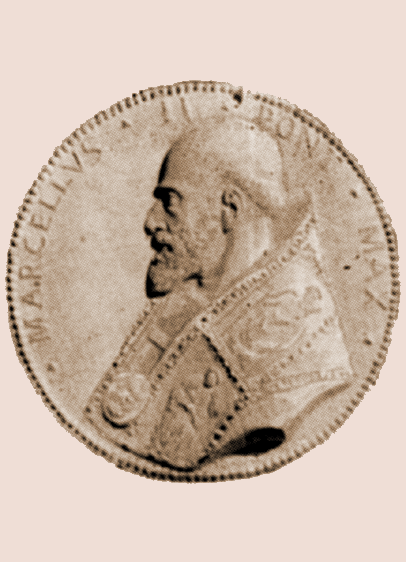Marcellus II
April 9, 1555 - May 1, 1555
EARLY BACKGROUND
Birth and Family
Pope Marcellus II was born Marcello Cervini degli Spannocchi in 1501 at Montepulciano, which is between Siena and Orvieto. His father was Apostolic treasurer in the Marches.
Education
Marcello studied in Siena and Rome.
Character
Unlike many churchmen who reached high office, Marcello lived a virtuous life, eschewing luxuries and high living.
CAREER UNDER LAST THREE POPES
Revision of Calendar under Clement VII
Pope Clement VII commissioned Marcello to complete a revision of the calendar that had been begun by Marcello's father. Both father and son were skilled in chronology, the science of arranging time in periods, which was part of their training as scholars and humanists.
Appointments under Paul III
Marcello's career prospered under Pope Paul III, who recognized his abilities and assigned him to a series of appointments and responsibilities.
●Protonotary Apostolic and Papal Secretary. Upon his election in 1534, Pope Paul III appointed Marcello Protonotary Apostolic and Papal Secretary.
●Advisor and Secretary to Young Farnese. Paul III appointed Marcello to act as an advisor and secretary to his grandson Cardinal Alessandro Farnese, to whom he had given considerable responsibility in managing political matters. In this capacity, Marcello accompanied the young cardinal on diplomatic missions and attended meetings with heads of state and other officials. This gave Marcello an opportunity to influence papal policy and gain valuable experience that would qualify him for further responsibility.
●Three bishoprics. Under Paul III, Marcello was named Bishop of Nicastro in 1539, of Reggio Emilia in 1540, and of Gubbio in 1544.
●Cardinalate in 1539. In 1539, Paul III created Marcello cardinal priest of Santa Croce in Gerusalemme.
●Legate to Imperial Court. Pope Paul made Marcello legate to the court of the emperor, Charles V.
●Co-President at 1545-47 Council of Trent. Cardinal Cervini was one of the three co-presidents sent by Paul III to the Council of Trent, where he doggedly pushed the papal agenda. The other two co-presidents were Cardinal del Monte, who became Pope Julius III, and Cardinal Reginald Pole.
●Reorganizing Papal Library. Paul III appointed Marcellus head librarian of the Vatican Library in 1548 and gave him the task of reorganizing the collections. He held the post until his election to the papacy in 1555.
Withdrawal from Rome under Julius III
As the head of a reform committee appointed by Paul III, Cardinal Cervini criticized Julius III for his extravagant lifestyle and for appointing his relatives to lucrative positions. Marcello spent most of Julius' pontificate in his diocese of Gubbio.
PONTIFICATE
Election as Pope
Because the factions supporting the French and the emperor were evenly balanced, the reform party was able to determine the choice of a compromise candidate.
Selection of Name
To emphasize that he was not changed by his election to the papal throne, Marcello kept his own name, becoming Pope Marcellus II. He was only the second pope of the last millennium to do so. (Hadrian VI had been the first.)
22-Day Pontificate
Coincidentally, Marcellus, like the other two Renaissance popes who had been dedicated to the idea of reform, Pius III and Hadrian VI, Marcellus had a particularly short pontificate. At 22 days, his term was one of the shortest in papal history.
Marcellus' health had always been uncertain, and he died of a stroke, which may have been precipitated by the fever pitch of his endeavors after his election.
Acts as Pope
Immediately after his election, Pope Marcellus began to initiate change and launch new projects.
●Cutting expenses. Pope Marcellus cut expenses drastically, beginning with his own investiture ceremony.
●Withholding employment from relatives. Pope Marcellus told his relatives not to come to Rome because he did not intend to employ them.
●Gathering reform plans. Marcellus gathered up a number of documents from Paul III's administration that were aimed at reforming the Church. It is believed that he intended to use them to draft a bull on reform and to outline a concrete plan of action.
Marcellus' Musical Legacy
Although in the end, Pope Marcellus did not have the time to make a substantial impact on church politics, his reforming spirit did inspire a contemporary composer, Giovanni Pierluigi da Palestrina, who Julius III had made choirmaster of the Julian Choir. Palestrina published a mass in 1567 entitled Missa Papae Marcelli, the Pope Marcellus Mass, in honor of the latter's memory. Appropriately, the mass represents Palestrina's attempt to reform church music--the piece is purged of any influence from secular music and is written in a style of polyphony, or music for multiple voices, which attempts to find a balance between the music and the words, maintaining the clarity of the text while still using the most modern musical form.




 Add Placemark
Add Placemark Go Back
Go Back 




